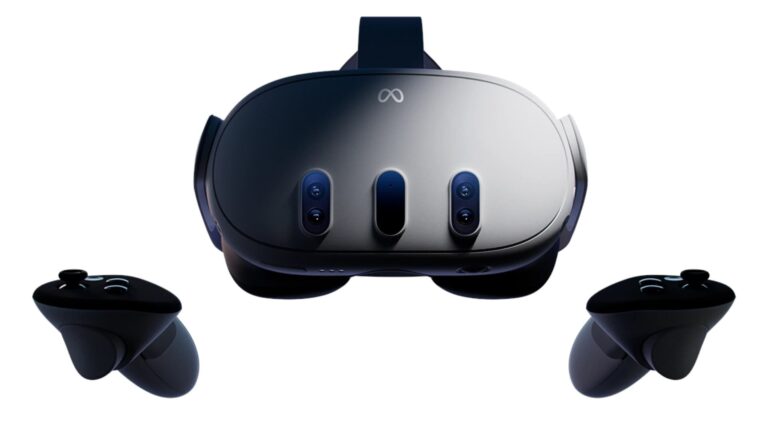
As we approach a new year, it’s time for our annual ritual of synthesizing the lessons from the past twelve months and formulating the outlook for the next twelve. 2023 was an incremental year for AR & VR, which both continue to gradually trudge uphill toward mainstream traction.
Highlights this year include the beginnings of XR’s convergence with AI, Apple Vision Pro’s unveiling, and some ups and downs for VR. 2023 was also defined by the rise of passthrough AR that’s incubated within VR a la Quest 3, as well as some smart glasses milestones.
These ends of the spectrum – passthrough AR and lightweight smart glasses – represent two paths towards AR’s holy grail. The former will get there through graphically rich UX in bulky form factors that slim down over time; while the latter gains UX richness to accompany its wearability.
Until then, what does spatial computing’s near-term look like? Aligned with the more extensive predictions of our research arm, ARtillery Intelligence, we’ve devised 5 AR Insider predictions. We’ll break them down weekly, continuing with prediction 4: Mixed Reality, the New VR Standard.
Prediction 1: AR and AI Get Hitched
Prediction 2: A Smart Glasses Turning Point
Prediction 3: New APIs & SDKs Elevate XR
Prediction 4: Mixed Reality, The New VR Standard
Prediction 5: Apple Vision Pro is Propelled by Wearables
Mixed Signals
There’s a new standard emerging in VR. Led in 2023 by Quest 3 and Vive XR Elite, mixed reality is becoming a primary feature in VR. This broadens VR’s appeal and use cases, including experiences that interact with the physical world as opposed to being occluded and insular.
These expanded use cases include everything from workplace productivity (think: floating virtual monitors), to gaming that interacts with one’s space. But beyond offering a more comprehensive set of VR use cases, mixed reality’s list of advantages include elevating AR.
In other words, the byproduct of mixed reality’s rise will be an acceleration in headworn AR exposure. This will happen as AR piggybacks on – and is incubated within – the more popular and penetrated VR format. More consumers will get a taste for headworn AR and like what they see.
Backing up, AR can be bisected into two formats: passthrough and see-through. Passthrough AR is offered in the above devices. And though it’s not AR’s endgame and ideal self – due to bulkier hardware that precludes all-day wearability – it offers advantages over seethrough AR.
Among those advantages, passthrough AR offers full control of every pixel of a VR display. This means greater definition, contrast, and field of view. See-through AR is conversely bound by physics such as manipulating light through waveguides, lenses, and optical combiners.
And because the background in seethrough AR is the physical world, it’s difficult to recreate the color black as you can with pixels on a display, leading to suboptimal contrast levels and washed-out images. Features like local dimming help, but several physical challenges persist.
Element of Affordability
As noted, the mixed-reality torch is being carried by Meta, given the positioning and priorities seen in Quest 3. But to be fair, Meta isn’t the first to market with passthrough AR. Hardware from Varjo for example has been available for a few years with high-quality color passthrough AR.
But Meta’s entrance, including its signature loss-leader pricing, has introduced the element of affordability, thus bringing mixed reality to a wider addressable market. This is where AR’s accelerated exposure noted above will factor in, given Meta’s greater mainstream reach.
The practical outcome of all the above is that Meta has established a new VR standard with Quest 3, which we’re predicting will become table stakes in 2024. As this plays out, and consumers get a taste for mixed reality, it will be difficult for VR players to compete without it.
Beyond consumer demand, developer dynamics and platform feature-parity will factor in. In other words, VR developers who want to offer mixed reality features or “MR modes” in their games will be attracted to platforms that offer that capability, putting others at a disadvantage.
Meanwhile, we can’t mention mixed reality without invoking Apple Vision Pro (AVP). Much of the above applies to AVP, however it will stand on its own at the high end (like Varjo hardware but more penetrated). Regardless, its classic halo effect will lift all boats in the MR sea.
Finally, stepping back, mixed reality is one bridge to AR glasses, the other being AI-powered smart glasses. The first track – AR via VR – will endeavor to slim down over time, while the second track – low-immersion smart glasses – aims to gain graphical richness over time.
The two tracks will meet in the middle. The big question is which will get there first.






